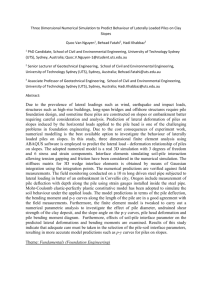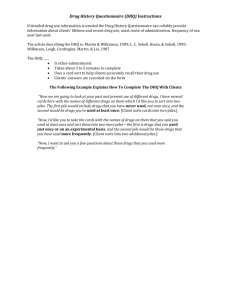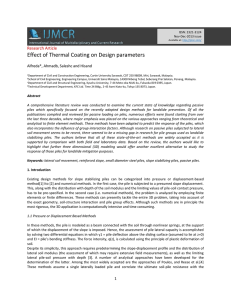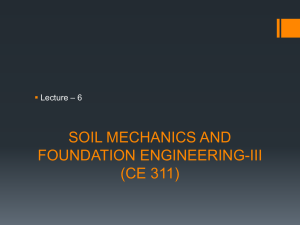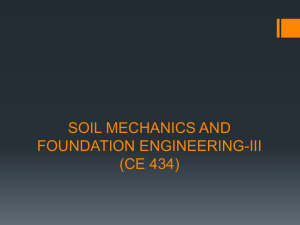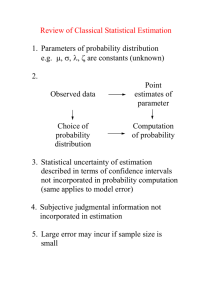Landslide & Slope Stabilization with Piles: WVDOT Research
advertisement
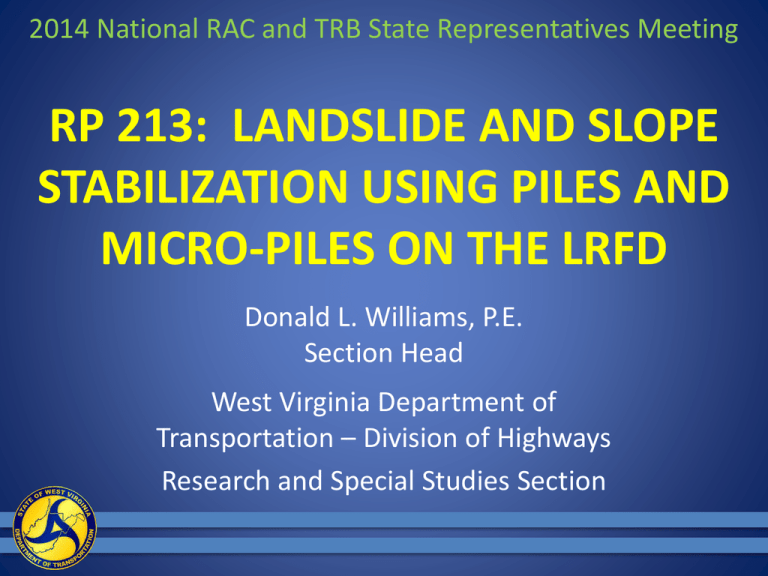
2014 National RAC and TRB State Representatives Meeting RP 213: LANDSLIDE AND SLOPE STABILIZATION USING PILES AND MICRO-PILES ON THE LRFD Donald L. Williams, P.E. Section Head West Virginia Department of Transportation – Division of Highways Research and Special Studies Section The Research Team • Principal Investigator: Mohamed Ashour, Ph.D., P.E. West Virginia University Tech • WVDOT-DOH Project Monitors: Joe Carte, P.E. Larry Douglass • Validation of Research Findings: Tia Como, P.E. Fairmont State University 2 The Problem 1. Landslides are a critical issue in West Virginia. 2. The WVDOT often uses driven, drilled, or micropiles to reduce the potential, or to prevent slope failures, stabilize bridge embankments, etc. 3. Prior to the RP 213 research, simplified methods based on crude assumptions were used in design. 3 The Problem 4. The major challenge lies in the evaluation of lateral loads (pressure) acting on piles by the moving soil. 4 The Problem 5. The interaction among piles including the lateral effective range of pile resistance is very complex. 6. A more sophisticated and proven analysis was needed to more realistically assess the destructive effect of the sliding soil mass. 7. The use of piles is a favorable practice, particularly when rock deposits lie to the ground surface; however, no effective or practical technique was available to address this condition. 5 The Research Objectives 1. Highlight the limitations of existing procedures currently used to address slope stabilization using piles. 2. Provide a design methodology for slope stabilization using driven/drilled/micro-piles based on limit equilibrium analysis and the Strain Wedge method. 3. Improve the level of certainty related to the downslope soil movement (small shoulder slopes and large slopes) and the induced distributed load along the stabilizing piles. 6 The Research Objectives 4. Incorporate soil and pile properties, and pile spacing in the analysis of stabilized slopes. 5. Develop the ability to input pre-existing landslide geometry and to estimate the resulting distributed driving forces. 6. Assess the shear force and moment developed along the pile based on the pile type (materials and dimensions) and the LRFD. 7 The Research Objectives 6. Provide a number of case studies and comparisons to validate and verify the research findings. 7. Establish a Windows-based computer program (PSSLOPE) and accompanying manual, customized to meet the needs of the WVDOH, to deal with small shoulder slips and large slips as well. 8 The Research Product: PSSLOPE 1. Limit equilibrium analysis and Strain Wedge (SW) model technique is used to assess slope stability before and after using driven piles. 2. Determines the mobilized driving force caused by sliding soil mass that needs to be transferred via piles to stable soil layers below the slip surface. 9 The Research Product: PSSLOPE 3. Graphic-user interface facilitates entering the input data and the analysis/plot of the output results. 10 Impact of Implementing Results 1. The research provides a reliable LRFD-based design procedure that is compiled into the PSSLOPE program for the analysis of pile-stabilized slopes. 2. The use of PSSLOPE will lower the chance of catastrophic failure and level of risk that the designers assume by using unreliable techniques based on questionable assumptions. 3. Designers have the ability to input pre-existing landslide geometry and to estimate the resulting driving forces. 11 Impact of Implementing Results 4. Cost savings or relief from a possible failure will be achieved. 5. The tedious manual iterations required in past practices are no longer necessary. 6. The design methodology demonstrates the suitability of pile-stabilized slopes; therefore, a mitigation plan for vulnerable slopes and bridge embankments can be established based on such knowledge. 12 Impact of Implementing Results 7. The use of the PSSLOPE software has been fully implemented by the WVDOT-DOH and is currently in use with great success. 8. Updates to the PSSLOPE software and users manual are currently in development. 13 Thank You Donald L. Williams, P.E. Section Head West Virginia Department of Transportation – Division of Highways Research and Special Studies Section (304) 677-4000 Donald.L.Williams@wv.gov 14
